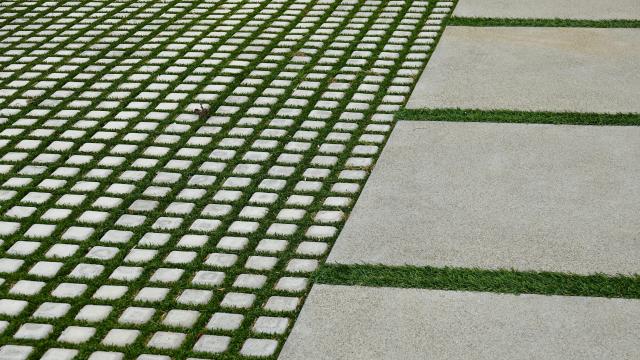Cost-effective, erosion-proof, and chemical-corralling, the mighty grass driveway doesn’t get the respect it deserves. But if you have rainwater rushing down your gravel driveway, washing away dirt or leaving trenches in its wake, it might be the solution for you. Using a system of interlocking pavers, a grass driveway is essentially a structured grid with enough space for grass or other plants to grow through, helping to absorb coursing water and preventing the ground from giving way.
It’s an ideal solution in areas where rain storms can cause a sudden deluge, or in places where longer periods of rain soak the ground, making it spongy and susceptible to erosion.
The benefits of having a grass driveway
In addition to helping to prevent erosion, grass driveways also help corral any chemicals your vehicle sheds as it sits in the driveway, including traces of gasoline, anti-freeze, and chemical deicers. Absorbing these substances before they end up in the storm drains — and subsequently in the water table — can help keep water contamination to a minimum.
Another benefit is that they’re simple to install and you can usually do it yourself. If you want to create a new driveway or parking area, you just need a flat or gently sloped piece of ground, a shovel, pavers, and your plants. Grid systems don’t even require much digging as they can be laid over existing grass and pushed into the soil. To use pavers, you need to remove the existing grass using a shovel, smooth out the area, lay your pavers, fill in the spaces between them with soil, and spread your grass seed. If you’re going with the split driveway method, you can use pavers to create the two tire tracks the same way you would lay masonry pavers. You can also pour concrete strips, but that’s more involved and requires more prep. (If you go this route, you might need to hire a pro.)
Grass driveways are also cost-effective. Since you can usually do the work yourself, you can save a lot of money. Also, the materials range from around $US700 up to the thousands, depending on the size of the area you want to cover and the type of paver you choose; paving a driveway, on the other hand, is likely to run you about twice as much.
How to create a grass driveway
To make a grass driveway, you’ll need to choose which type to go with. Concrete pavers cut into a grid shape, plastic grid pavers, and split driveways, also known as ribbon driveways, are all ways to incorporate some plant life into your paved area. Depending on how you want your surface to look, choosing masonry, a grid system that will be mostly invisible, or a pair of strips with plants in between will all give you very different looks.
Once you’ve picked your pavement type, choosing plants that will survive being driven over is also important. In addition to the look and tenacity of the plants you choose, consider your climate as well. You’ll need grass options that will help absorb water and will withstand the weight of a car. For other driveway plants, you can also try clover and thyme — these will withstand a certain amount of abuse and still come back for more.

Leave a Reply
You must be logged in to post a comment.